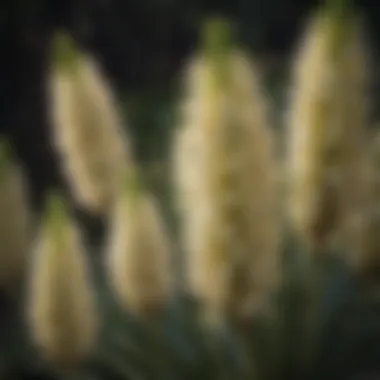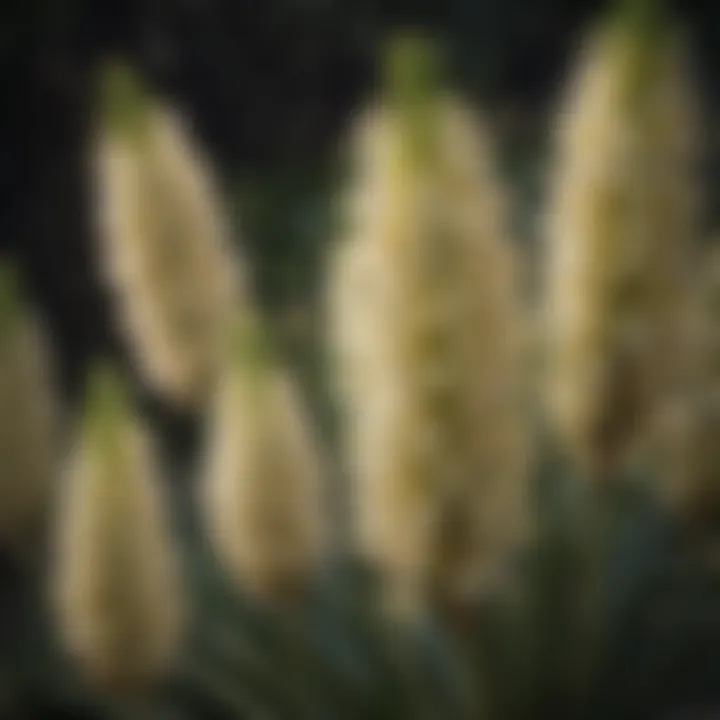Exploring the Rich Diversity of Yucca Plants


Intro
Yucca plants are often overlooked in discussions about biodiversity and the ecosystems they inhabit. These plants exhibit remarkable adaptability and resilience, thriving in an array of environments, from deserts to subtropical regions. Their unique features not only contribute to the aesthetics of landscapes but also play a crucial role in the habitats they occupy. Understanding the diverse types of yucca plants provides valuable insight into their ecological significance and the factors responsible for their survival in various habitats.
The yucca genus encompasses numerous species, each possessing distinct characteristics suited to their environments. The significance of these plants extends beyond mere ornamental value; they are essential components of woodland ecosystems, playing vital roles in terms of plant diversity and interactions with wildlife. This article aims to explore the types of yucca plants, their unique adaptations, and their contributions to the ecosystems around them.
Understanding Woodland Ecosystems
Woodland ecosystems offer a unique blend of habitats where yucca plants can flourish alongside a variety of other flora and fauna.
Importance of Biodiversity in Forests
Biodiversity is fundamentally important in woodland ecosystems. It enhances resilience to environmental changes and supports a wide range of species interactions. Some of the advantages of biodiversity include:
- Stability: Diverse ecosystems are better equipped to withstand disturbances such as diseases and climate fluctuations.
- Nutrient Cycling: Various species contribute to the cycling of nutrients, promoting soil health and fertility.
- Habitat Availability: Different plant species provide habitats for a multitude of wildlife, ensuring a balanced ecosystem.
Role of Forests in Climate Regulation
Forests play a critical role in climate regulation. They act as carbon sinks, absorbing carbon dioxide from the atmosphere and mitigating the effects of climate change. Additionally, forests influence local climates through:
- Evapotranspiration: Trees release water vapor, affecting humidity and temperature levels.
- Shade Provision: Plant canopies can reduce surface temperatures, promoting a more stable microclimate.
- Windbreaks: Forests can act as natural barriers against strong winds, preserving soil moisture and protecting smaller plants.
"Understanding the symbiotic relationships within ecosystems is key to appreciating the roles of diverse plant species, such as yucca, in maintaining ecological balance."
In summary, this section emphasizes the essential nature of biodiversity within woodland ecosystems and how forests significantly contribute to climate regulation. The presence of yucca plants in these environments supports not just their beauty but also the functionality and sustainability of the ecosystems.
Prelude to Yucca Plants
Yucca plants are a notable genus within the Asparagaceae family, recognized for their resilience and adaptive traits. Understanding yucca plants is essential for appreciating their role in various ecosystems. This article aims to shed light on the distinctive characteristics, habitats, and ecological importance of these plants. By exploring yucca plants, readers can gain insight into their contributions to biodiversity and how they coexist with other species in their environments.
Defining the Yucca Genus
The yucca genus consists of approximately 40 species, primarily found in the Americas, although some can also be located in the Caribbean. These plants display a range of physical attributes and reproductive strategies that enable them to thrive in diverse habitats. Generally, yuccas are characterized by their sword-shaped leaves, stiff growth patterns, and prominent flower stalks. Many species are also equipped with sharp leaf tips, adapting them well to arid conditions.
The yucca plants' adaptability to varied climatic conditions plays a crucial role in their definition as a genus. They can be found in sandy deserts, rocky hillsides, and subtropical forests, showcasing their versatility in surviving harsh environments. Each species reflects unique ecological adaptations that make them significant components of their respective habitats.
Significance in Eco-systems
Yucca plants hold substantial ecological value. They not only contribute to the flora of their environments but also play an intricate role in the local ecosystems. One of the critical aspects of their significance lies in their relationships with pollinators. For instance, certain yucca species depend exclusively on specific moth species for pollination. This mutualistic bond highlights the intricate connections within ecosystems, as the moths rely on the yucca for food and reproduction while helping the plants to propagate.
Beyond their role in pollination, yuccas also provide habitat and sustenance for various wildlife, including insects, birds, and mammals. Their fibrous leaves and flowers supply food sources for herbivores. Additionally, yucca roots and other plant parts have been used in traditional medicine by indigenous cultures, showcasing their broader significance in human history.
"Yucca plants exemplify the intricate links between flora and fauna within ecosystems, highlighting how specialized relationships shape biodiversity."
In summary, the introduction to yucca plants unfolds the layers of understanding their ecological importance and the necessity of conserving their habitats. Knowing how yucca plants operate within wider environmental contexts underscores their relevance in both nature and culture.
Characteristics of Yucca Plants
The characteristics of yucca plants are essential for understanding their ecological importance and practical applications. These traits include physical attributes and adaptations that enable yucca species to thrive in varied environments. By examining these attributes, one can appreciate the resilience, beauty, and utility of yucca plants. This section focuses on the distinct features of yucca plants, which play a significant role in their interaction with the ecosystem.
Physical Attributes
Leaf Structure
The leaf structure of yucca plants is notable for its narrow, tough, and often pointed leaves. These leaves are not only hardy but also minimize water loss, which is crucial in arid environments. Yucca leaves can grow in a rosette pattern, creating a striking visual impact. This characteristic makes them a popular choice in landscaping where drought-resistant plants are desired. The unique structure contributes to their ability to withstand harsh conditions, although it may pose challenges in urban areas where softer foliage could be more suitable for certain aesthetics.
Stem Types
Yucca plants exhibit various stem types, ranging from short and thick to tall and slender. Some species exhibit a trunk-like structure, while others resemble more of a shrub form. This variation allows yuccas to adapt to their specific habitats. For instance, Yucca brevifolia, or the Joshua Tree, has a tall, branching stem that can reach impressive heights. This adaptability offers benefits in different ecosystems but may limit their growth in areas with significant competition for sunlight.
Flowering Characteristics


Yucca plants are also known for their distinct flowering characteristics. The flowers are typically bell-shaped and can be quite large, often arranged in clusters. Pollination is mainly facilitated by specific insects such as the yucca moth, illustrating a unique symbiotic relationship. Flowering can occur in specific seasons depending on the species, contributing to the plant's reproductive success. However, while flowering enhances the plant's ecological role, it can be a disadvantage if the plants are not located in an area with suitable pollinators.
Adaptations to Environment
Drought Resistance
Drought resistance is one of the standout adaptations of yucca plants. They have developed several mechanisms to conserve water, such as a waxy leaf coating and a shallow root system. These traits enable yuccas to absorb moisture quickly after rain events. This characteristic makes them highly valued in xeriscaping, an important practice in sustainable landscape design. However, while these adaptations are beneficial, excessive moisture can lead to root rot, posing a risk in overly wet environments.
Sunlight Requirements
Yucca plants generally prefer full sunlight to partial shade. Their leaves are adapted to cope with high radiation levels, which boosts photosynthesis and growth. This requirement benefits gardeners looking to attract sun-loving plants. However, not all species can thrive in shaded environments, limiting their use in certain landscape designs. Understanding the sunlight needs of specific yucca species can greatly enhance their growth and longevity.
Salt Tolerance
Salt tolerance is another significant adaptation. Certain yucca species can thrive in saline soils, making them suitable for coastal areas or regions affected by high salt levels. This tolerance allows them to survive where other vegetation may struggle. While salt-tolerant yuccas can be used ingeniously in urban landscaping, their presence may not enrich all types of ecosystems, as their adaptability can sometimes limit the diversity of plant life in an area.
"Yucca plants are remarkable examples of resilience and adaptation, serving multiple roles in their ecosystems."
Exploring the characteristics of yucca plants highlights their complexity and adaptability. This understanding is crucial for forestry professionals and ecologists who aim to utilize these resilient plants in various applications.
Key Yucca Species
Yucca plants are a diverse genus that comprises numerous species, each possessing unique characteristics and adaptations. Understanding different yucca species is important as it provides a broader view of their ecological roles, benefits, and overall significance. This section offers insights into four prominent species: Yucca filamentosa, Yucca brevifolia, Yucca gloriosa, and Yucca aloifolia. Each of these species plays a vital role in its habitat, supports local ecosystems, and offers various uses that range from ornamental to practical applications.
Yucca filamentosa
Habitat
Adam's needle thrives in sandy soil and is often found in dry, open areas, including grasslands and the edges of forests. It shows remarkable adaptability to different soil types, making it a resilient choice for cultivation. However, this species can struggle in overly saturated environments, which can lead to root rot. Therefore, planting it in well-draining soils is crucial for its success and longevity.
Uses
Aside from its ornamental qualities, Yucca filamentosa has various uses. The thick leaves are rich in saponins, which can be processed to create natural soaps. Additionally, the plant has been used in traditional medicine for its potential anti-inflammatory properties. This multi-functionality makes it a favored choice among gardeners and herbalists alike.
Yucca brevifolia
Habitat
This species is found primarily in the Mojave Desert, where it thrives in well-drained, sandy soils. It is remarkably drought-resistant, adapting to the desert's arid climate. However, as a keystone species, the Joshua tree is sensitive to climatic changes. Its decline can indicate ecological issues in its environment, illustrating its importance in biodiversity.
Uses
The Joshua tree has cultural significance, particularly among Indigenous communities. The fibrous leaves were traditionally used to make baskets and mats, showcasing its practical value. Its striking appearance also makes it a popular subject for photography and art, plus an attraction for ecotourism in its natural habitat.
Yucca gloriosa
Habitat
This species grows best in well-drained soils common near the Atlantic coastal plain. Yucca gloriosa prefers sunny locations, but it can also survive in partial shade. However, it may struggle in colder climates, limiting its cultivation in some areas. Understanding its habitat requirements is key to successful growth.
Uses
Yucca gloriosa is often utilized in landscaping for its ornamental qualities. The flowers are edible and can be used in various dishes, showcasing the plant's culinary potential. Furthermore, the leaves can be used for making natural twine due to their toughness, which adds to its practical benefits.
Yucca aloifolia
Habitat
This species is typically found along coastal regions, thriving in sandy soils and salt-spray environments. Its adaptability to saline conditions makes it an important species for coastal gardens. However, caution is needed in overly moist soil conditions as it can lead to fungal issues.
Uses
Aside from its stark beauty and resilience, Yucca aloifolia has been used in traditional crafts and cooking, showing its versatility. The fibers from the leaves can be crafted into ropes or mats. Additionally, its flowers are edible and have been used in culinary dishes, which adds an interesting dimension to its profile.


Understanding the distinct traits of these key yucca species allows for better appreciation and utilization within landscapes and ecosystems. Such knowledge promotes biodiversity, acknowledging the role each species plays in maintaining environmental balance.
Yucca in Biodiversity
Yucca plants play a pivotal role in the ecology of the regions they inhabit. Their unique adaptations allow them to survive in harsh conditions, which in turn supports various forms of life. Understanding the biodiversity surrounding yucca plants is essential for conservation efforts and for maintaining ecosystem balance. Yuccas offer both direct and indirect benefits to the environment, making them important contributors to regional biodiversity.
Role in Ecosystem Balance
The function of yucca plants in ecosystem balance cannot be overstated. As perennials, yuccas contribute to soil stabilization. Their deep root systems help prevent erosion, especially in arid environments where soil is easily displaced. Furthermore, the organic matter from decaying yucca leaves enhances soil fertility, supporting other plant species. This results in diverse plant communities and improves habitat quality.
Yuccas also provide shelter and food for various organisms. Their large, stiff leaves offer cover for small mammals and nesting sites for birds. This protective function contributes to the stability of animal populations. Additionally, yuccas influence the microclimate of their surroundings, providing shade that benefits understory plants and wildlife.
Interactions with Fauna
Understanding interactions between yucca plants and fauna enhances our knowledge of ecosystem dynamics.
Pollination Relationships
Pollination relationships are a crucial aspect of yucca biodiversity. Yucca plants are known for their unique partnership with the yucca moth. This moth has specialized adaptations that allow it to directly pollinate yucca flowers while laying its eggs. The flower’s structure is designed to only facilitate this specific moth, which highlights the exclusive nature of this relationship.
The mutual benefits of this pollination system are significant. The moth gets a safe place for its larvae, while the yucca ensures successful reproduction. This relationship exemplifies co-evolution, demonstrating how dependent species can develop interconnected survival strategies, contributing to the ecological health of their environment.
Habitat for Wildlife
Yuccas also serve as habitat for diverse wildlife. Various species utilize the foliage and flowers for shelter and sustenance. The plant’s thick leaves provide a significant cover for insects and small mammals, improving species richness in the area.
A unique characteristic of yucca habitats is their ability to support various trophic levels. The flowers attract pollinators, which in turn may support insectivorous birds and other predators. This interplay promotes a balanced ecosystem, where different species rely on each other for food and habitat, contributing to overall biodiversity.
"Yuccas are not just plants; they are vital components of their ecosystems, supporting a myriad of life forms while adapting to the rigors of their environment."
Culinary and Medicinal Uses of Yucca
Yucca plants offer both culinary and medicinal benefits that deserve attention in discussions about their significance. Understanding the uses of yucca enriches the appreciation of this genus and highlights its versatile nature. In culinary practices, various species provide nutrition and flavor. Medicinally, yucca has historical and contemporary applications that can aid in health management. Exploring these aspects illuminates how humans have interacted with yucca plants throughout history and continue to do so today.
Nutritional Properties
The nutritional profile of yucca is remarkable. The roots of yucca, primarily from the species Yucca elata and Yucca filamentosa, are starchy and nutritious. They are often consumed in several cultures, particularly in South America and the Caribbean. The following points highlight the nutritional benefits of yucca:
- Rich in Carbohydrates: Yucca is high in carbohydrates, making it an energy-dense food. This aspect is essential for people engaging in hard physical labor or requiring high energy in their diet.
- Source of Vitamins: It contains vitamins such as C and B-complex vitamins. These nutrients support various bodily functions, including boosting the immune system and improving metabolic processes.
- Mineral Content: Yucca root also provides essential minerals, like potassium, calcium, and magnesium, which are important for maintaining various physiological functions.
The roots can be cooked, roasted, or used in soups. However, they must be prepared properly to ensure safety since some species can contain saponins, which can be toxic in large quantities. Knowledge of these properties enhances the culinary use of yucca and underlines its importance as a food source.
Traditional Medicinal Uses
Yucca has long been recognized in traditional medicine for its therapeutic properties. Various indigenous cultures have utilized different parts of the yucca plant for health purposes. Some notable traditional uses include:
- Anti-Inflammatory Properties: Consumption of yucca is thought to help reduce inflammation, making it a choice for conditions like arthritis. The roots can be consumed or made into poultices for topical application.
- Digestive Aid: Yucca is known to support digestive health. Its high fiber content promotes regular bowel movements and may help with gut health, providing a natural approach to preventing constipation.
- Skin Health: The extracted sap of yucca can be applied to wounds or skin irritations. This traditional remedy is believed to foster healing and reduce infection risk.
Additionally, yucca is sometimes used as a natural supplement for its purported benefits in overall wellness. While more research is needed to confirm these uses, the historical applications underscore the plant's significance in cultural practices.
"Yucca serves as both nourishment and medicine in many traditions, illustrating the interconnectedness of health and nature."
In summary, exploring the culinary and medicinal uses of yucca enriches our understanding of this remarkable plant. Its nutritional properties provide energy and essential nutrients, while traditional medicinal uses highlight its value in health management. As interest in natural remedies and diverse diets grows, yucca can play a relevant role in contemporary health practices.
Cultivation and Care for Yucca Plants
Cultivating yucca plants requires an understanding of their specific needs concerning soil, water, and light. These elements are vital for ensuring successful growth and maintaining the overall health of the plants. Attention to these details helps to create an environment where yucca plants can thrive while minimizing the risk of pests and diseases.
Growing Conditions
Soil Preferences
Yucca plants prefer well-draining soil. This characteristic is crucial because yucca is adapted to arid conditions, and excess moisture can lead to root rot. Sandy or loamy soils are often beneficial choices for planting yucca. They provide necessary drainage while retaining some moisture. It is essential to avoid heavy clay or compacted soils, which can hinder their growth. The unique feature of well-draining soil helps yucca to establish deep roots, resulting in more resilient plants.


Watering Schedule
The watering schedule is another important aspect of yucca plant care. Generally, yucca plants should be watered infrequently. They store water in their roots and leaves, making them drought-tolerant. A common recommendation is to water only when the top inch of soil feels dry. This method encourages deep root growth. Overwatering can lead to a range of issues, including fungal infections and decreased plant vigor. Hence, a concise watering schedule supports healthy yucca plants in any setting.
Light Requirements
Yucca plants thrive in bright, direct sunlight. Adequate light is important to promote their growth and flowering. Ideally, they should receive at least six hours of sunlight each day. Insufficient light may lead to weak growth and reduced flower production. While some species can tolerate partial shade, direct exposure generally enhances their resilience. Understanding these light requirements contributes significantly to successful cultivation and care of yucca plants.
Pest and Disease Management
Effective pest and disease management ensures that yucca plants remain healthy. Identifying issues early prevents extensive damage and promotes longevity.
Common Pests
Common pests that affect yucca include spider mites, aphids, and mealybugs. These pests can detrimentally impact plant health by sucking sap from their leaves and stems. Regular inspection allows for early detection of infestations. Employing natural predators or insecticidal soaps can effectively manage these pests without harming the plants. Addressing pest issues promptly contributes to maintaining the ecosystem balance in which yucca plants thrive.
Disease Identification
Recognizing symptoms of diseases is essential for effective intervention. Diseases like root rot and leaf spots can manifest in yucca. Root rot is often indicated by wilting and brown roots. Leaf spots appear as dark, water-soaked areas on foliage. Identifying these symptoms early allows for timely actions, such as adjusting watering schedules or improving soil drainage, thereby reducing the risk of future outbreaks.
Preventative Measures
Implementing preventative measures offers a proactive approach to care for yucca plants. Ensuring proper drainage through soil amendments and avoiding overcrowding can prevent many common problems. Additionally, maintaining clean gardening practices helps minimize pests and diseases. Utilizing resistant plant varieties can also be a beneficial strategy toward long-term health and vitality. Overall, preventative measures support sustainable cultivation, thereby enhancing the ecological contributions of yucca plants throughout their lifespans.
"Understanding the unique requirements of yucca plants fosters a harmonious relationship between cultivation and care, ensuring the health of these remarkable plants."
Yucca's Cultural Significance
Yucca plants hold a special place in various cultures around the world. Their significance extends beyond mere botanical interest; they embody historical, cultural, and practical aspects that have shaped human interactions with nature. Understanding yucca's cultural significance allows us to appreciate how these plants have influenced traditions, practices, and even livelihoods.
Historical Uses by Indigenous Cultures
Many indigenous groups have utilized yucca in a variety of ways. This plant provides not only sustenance but also tools and materials that are essential in daily life. The roots of the yucca plant are rich in saponins. These compounds can be extracted to create natural soaps and cleansing agents. Native tribes often relied on this property for their hygiene and cleansing rituals.
Furthermore, the fibers from yucca leaves are strong and durable. They were woven into ropes, baskets, and even clothing. For example, the yucca filamentosa species provided materials for the populations living in desert regions, facilitating their survival in harsh environments.
Additionally, some indigenous cultures used yucca in spiritual practices. This plant was sometimes considered sacred, featuring in rituals and ceremonies that acknowledge its significance. Notably, the abundant flowering of yucca is thought to represent life and rebirth, reinforcing its role in the cultural memory of these communities.
Modern Cultural References
Today, yucca continues to feature prominently in various aspects of contemporary culture. It is often found in landscaping and gardening, valued for its aesthetic appeal and drought resistance. Urban areas have embraced yucca plants as ornamental additions, reflecting their adaptability and resilience in urban settings.
In culinary contexts, various yucca species, such as yucca root, are incorporated into various dishes, particularly in Latin American cuisine. The root is often cooked and mashed or fried, making it a staple ingredient in many households.
Moreover, the yucca plant has become a symbol of environmental sustainability. This plant is admired for its low maintenance requirements and ability to thrive in poor soil conditions. As the world grapples with climate change, people look toward yucca as a possible solution for sustainable landscaping and gardening practices.
"Yucca plants, with their rich history and versatility, symbolize resilience and adaptability in both nature and culture."
Overall, the cultural significance of yucca plants is marked by their historical roles, current applications, and future potential. By examining these aspects, we can gain a deeper understanding of yucca's impact on various cultures throughout time.
Ending
The conclusion plays a vital role in summarizing the exploration of yucca plants. It encapsulates the critical insights gained from the previous sections, bringing clarity to the diverse nature of these remarkable species. Understanding the various types of yucca plants enriches appreciation for their ecological roles and diversity.
Within this article, readers have learned about specific species such as Yucca filamentosa, which thrives in a range of habitats, and Yucca brevifolia, known for its iconic presence in the Mojave Desert. Their adaptations to environments, culinary uses, and cultural significance have also been highlighted. These points emphasize that yucca plants are more than decorative shrubs; they are integral to ecosystem function.
Moreover, the conclusion serves as a platform for future considerations. The discussion on the future relevance of yucca in ecology showcases ongoing research and potential changes in environmental conditions. As biodiversity decreases globally, understanding such resilient plants becomes essential for maintaining ecological balance.
"Yucca plants exemplify resilience and adaptability, serving not only as crucial components of their ecosystems but also as resources for human use."
Summary of Key Points
- Diversity of Species: There are multiple yucca species, each with unique characteristics.
- Ecological Role: Yucca plants contribute significantly to their ecosystems, providing habitat and food.
- Culinary and Medicinal Uses: Some yucca species have nutritional benefits and medicinal properties.
- Cultural Significance: Indigenous cultures have utilized yucca plants across history.
- Adaptation and Resilience: Their ability to thrive in diverse environments showcases their resilience.
Future Relevance of Yucca in Ecology
The future relevance of yucca in ecology cannot be understated. As climate change affects habitats, yucca plants may play an increasingly important role in conservation efforts. Their drought resistance and adaptability position them as candidates for sustainable landscaping in arid regions. Furthermore, ongoing research into their ecological interactions can provide insights into ecosystem stability.
In summary, the yucca genus constitutes a remarkable aspect of biodiversity that deserves continued study and appreciation. As environmental challenges persist, understanding the role of yucca plants will be crucial in fostering ecological health and resilience.







